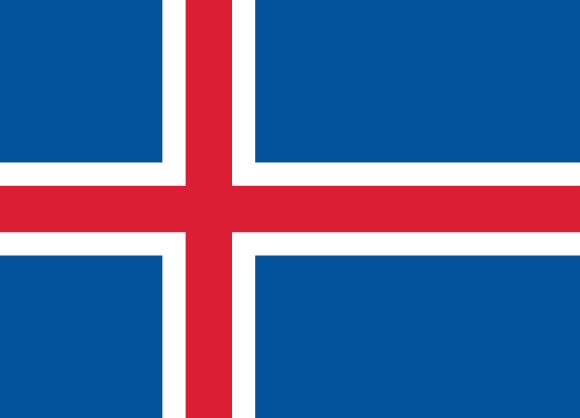Iceland Flag

Iceland's national flag is a horizontal tricolor with a white cross on a blue background and a red cross inside the white cross. This design dates back to 1915, when it was approved as the Icelandic national flag following Denmark's grant of statehood in 1918.
The colors of the flag represent the country's natural landscape, with red representing the volcanoes' fire, white representing the ice and snow that covers the island, and blue representing the mountains. The cross represents Christianity, which has long been a component of Icelandic society. The flag was formally defined in Law No. 34, which was enacted on June 17, 1944, the day Iceland became a republic.
Iceland flag downloads
- completely free for commercial and non-commercial use (public domain)
- based on vector file from Wikipedia Commons
- PNG or WebP format (lossless compression)
- Right click on the links (save link as)
| Width | Height | PNG | WebP |
|---|---|---|---|
| 20px | 14px | ~0.1 KB | ~0.1 KB |
| 40px | 29px | ~0.4 KB | ~0.1 KB |
| 80px | 58px | ~0.7 KB | ~0.1 KB |
| 160px | 115px | ~2.6 KB | ~0.6 KB |
| Width | Height | PNG | WebP |
|---|---|---|---|
| 16px | 12px | ~0.1 KB | ~0.1 KB |
| 40px | 30px | ~0.4 KB | ~0.1 KB |
| 80px | 60px | ~0.8 KB | ~0.1 KB |
| 128px | 96px | ~2.5 KB | ~0.6 KB |
- completely free for commercial and non-commercial use (public domain)
- based on vector file from Wikipedia Commons
- PNG, WebP (lossless compression) or JPEG format (100% quality)
- Right click on the links (save link as)
| Width | Height | PNG | WebP | JPEG |
|---|---|---|---|---|
| 2560px | 1843px | ~2.6 KB | ~0.6 KB | ~34.9 KB |
| 1280px | 922px | ~0.7 KB | ~0.1 KB | ~13.0 KB |
| 640px | 461px | ~0.4 KB | ~0.1 KB | ~5.6 KB |
| 320px | 230px | ~0.2 KB | ~0.1 KB | ~2.8 KB |
| 160px | 115px | ~0.1 KB | ~0.1 KB | ~1.5 KB |
| 80px | 58px | ~0.1 KB | ~0.1 KB | ~0.9 KB |
| 40px | 29px | ~0.1 KB | ~0.1 KB | ~0.6 KB |
| 20px | 14px | ~0.1 KB | ~0.1 KB | ~0.4 KB |
- completely free for commercial and non-commercial use (public domain)
- based on vector file from Wikipedia Commons
- SVG, PDF (Adobe Acrobat), AI (Adobe Ilustrator) or EPS format
- Right click on the links (save link as)
| Format | SVG | AI | EPS | |
|---|---|---|---|---|
| Vector download | ~0.3 KB | ~12.5 KB | ~29.7 KB | ~1533.8 KB |
Country information
Iceland is a country located in the North Atlantic Ocean. It is an island nation, with no land borders. The capital of Iceland is Reykjavik, which is located in the western part of the country and is the largest city.
Iceland has a population of approximately 364,000 people, and the official language is Icelandic. The country has a diverse population, with a mix of Scandinavian and Celtic influences. The main religion in Iceland is Christianity, with the majority of the population being Lutheran.
Iceland has a subarctic climate, with cold winters and cool summers. The country is known for its beautiful landscapes, which include glaciers, geysers, and waterfalls. It is also home to a number of national parks and protected areas, which are home to a wide range of plant and animal species, including whales, seals, and a variety of birds.
The economy of Iceland is primarily based on service industries, with the main sectors being tourism, finance, and healthcare. The manufacturing sector is also an important contributor to the economy, with the country producing a wide range of products, including textiles, clothing, and electronic goods. The fishing industry is also a significant contributor to the economy, with the country being one of the world's largest exporters of seafood.
| Independent | Yes |
| Country codes | IS, ISL (ISO 3166-1) |
| Official name | Iceland |
| Official languages | Icelandic |
| Religion | 72.4% Christianity, 25.2% No religion, 1.5% Ásatrúarfélagið, 0.9% Others |
| Capital city | Reykjavik |
| Continent | Europe |
| Time zone | UTC (GMT/WET) |
| Member of | United Nations |
| NATO | |
| Nordic Council | |
| Population | 346,884 (2023) |
| Population density | 3 per Km2 (9 people per mi2) |
| Urban Population | 94.4 % of the population is urban (322,286 people in 2020) |
| Migrants (net) | 380 |
| Median age | 37.5 years |
| Total area | The total land area is 100,250 Km2 (38,707 sq. miles) |
| Highest point | Hvannadalshnúkur (2 110 m, 6 923 ft) |
| Lowest point | North AtlanticOcean |
| GDP per capita | $ 68,727 (World Bank, 2021) |
| Currency | Icelandic króna (kr, ISK) |
| Calling code | +354 |
| Internet TLD | .is (click here to find and register domain name) |
| Country Wikipedia Page | Iceland Wikipedia Page |
Main Cities by Population in Iceland
| # | CITY NAME | POPULATION |
|---|---|---|
| 1 | Reykjavik | 118,918 |
| 2 | Kopavogur | 31,719 |
| 3 | Hafnarfjoerdur | 26,808 |
| 4 | Akureyri | 17,693 |
